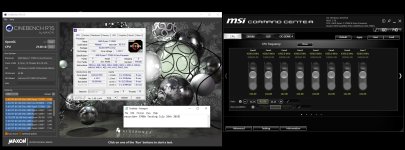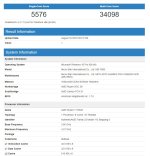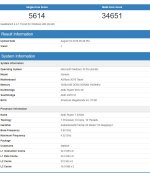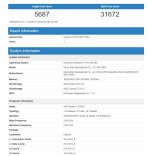@easyrider @willhub what maximum boost clock are you seeing on a single core, are you getting 4.4GHz?
Nope and Ive just changed my Power to standard balanced over ryzen balanced and now see this... voltage

And found this Rediit post
The final word on idle voltages for 3rd Gen ryzen
Tech Support
Hi, everyone. I've spoken to many of you publicly or privately over the past 48H to better understand why you are seeing idle voltages the community considers to be high. Some of the
back-and-forth was covered in this thread, but I wanted to submit my own post to bring more visibility to this topic. We have a final answer for you.
Understanding What's Going On
We have determined that many popular monitoring tools are quite aggressive in how they monitor the behavior of a core. Some of them wake every core in the system for 20ms, and do this as often as every 200ms. From the perspective of the processor firmware, this is interpreted as a workload that's asking for sustained performance from the core(s). The firmware is designed to respond to such a pattern by boosting: higher clocks, higher voltages.
The Effect of This Pattern
So, if you're sitting there staring at your monitoring tool, the tool is constantly instructing all the cores to wake up and boost. This will keep the clockspeeds high, and the corresponding voltages will be elevated to support that boost. This is a classic case of observer effect: you're expecting the tool to give valid data, but it's actually producing
invalid data by virtue of how it's measuring.
What about Ryzen Balanced vs. Windows Balanced Plan?
By now, you may know that 3rd Gen Ryzen heralds the return of the Ryzen Balanced power plan (
only for 3rd Gen CPUs; everyone else can use the regular ol' Windows plan). This plan specifically enables the 1ms clock selection we've been promoting as a result of CPPC2. This allows the CPU to respond more quickly to workloads, especially bursty workloads, which improves performance for you. In contrast, the default "Balanced" plan that comes with Windows is configured to a 15ms clock selection interval.
Some have noticed that switching to the Windows Balanced plan, instead of the Ryzen Balanced Plan, causes idle voltages to settle. This is because the default Balanced Plan, with 15ms intervals, comparatively instructs the processor to ignore 14 of 15 clock requests relative to the AMD plan.
So, if the monitoring tool is sitting there hammering the cores with boost requests, the default plan is just going to discard most of them. The core frequency and clock will settle to true idle values now and then. But if you run
ourperformance-enhancing plan, the CPU is going to act on every single boost request interpreted from the monitoring tool. Voltages and clock, therefore, will go up. Observer effect in action!
Okay, Rob. Shhhhh. Just Tell Me How I See Voltages? I Just Wanna Check!
CPU-Z does an excellent job of showing you the current/true idle core voltage without observer effect. In my
example image, I've configured a Ryzen 9 3900X with all the same things we would advise the public to use: Windows 10 May 2019 Update, the latest BIOS for the Crosshair VIII, and chipset driver 1.07.07 (incl. the AMD power plan). Yes, we're monitoring the behavior of the core, but we can see that idle voltage looks great. The tool is not compelling the firmware to boost when it's not needed.
Is There Anything Else I Need To Know?
Yes, actually. The Ryzen CPU depends heavily on a low-power state called cc6 sleep. In this sleep state, core clockspeeds and voltages are basically nil as the core is sleeping and gated. It is not possible to report out the state of the core in this sleep state without waking the core, probing the status, and killing the power savings of cc6. Therefore,
MOST tools can only show you the last clock and voltage of the core before the core went to cc6. So if you were at full 4.5GHz+ boost @ 1.48V, then the core went to sleep, many tools might show the core(s) stuck at that value. The tool just doesn't know any better.
However, the latest version of AMD Ryzen Master can uniquely show you clocks and voltages in a cc6 state. No other tool can do it. Neat piece of info for the people looking to understand how their core behaves!
tl;dr: Observer effect bad. You can't always trust your tools. CPU-Z gives you the right idle voltage. We'll look at the rest. Thank you everyone for your reports and insight, which helped us get to the bottom of this once and for all.
//EDIT: To ensure you're following my instructions correctly:
- Do not have two different monitoring apps running to compare them, e.g. Ryzen Master and CPU-Z. Or CPU-Z andHWINFO. I see many folks trying to run two apps at the same time, so they can compare behavior. This can cause a race condition, which will affect your results.
- Just run CPU-Z at the desktop, by itself, with no other monitoring apps going.
- Don't forget background apps like Corsair iCue, NZXT CAM, or software that came with your mobo are also monitoring tools.
- Make sure all BIOS voltage settings are set to NORMAL or AUTO. Only enable your XMP profile for the purposes of this test.
- Make sure you have chipset driver 1.07.07 (from amd.com), Windows 10 v1903, and the latest BIOS for your motherboard.
- Do not worry if your processor is not exactly matching mine with voltage. All we're looking for is the CPU to go to < 1.0V when you're staring at CPU-Z doing nothing. This indicates idle is workig correctly.
- If you are 100% convinced that you've followed my steps correctly and you're still seeing 1.38V+ idle voltages, PLEASE FILL OUT THIS FORM (it's anonymous!).
//EDIT @ 07/12/2019, 00:14 UTC:
I'm specifically looking for reports where the voltage is stuck at a particular value, or a small range of values, around 1.4V--no matter how long you sit there and watch it. It is perfectly okay if your CPU is periodically using 1.4-1.5V to achieve boost frequencies, and you should see dips into sub-1.0V as the CPU goes into idle. These dips may be brief, and that's okay. Load voltages of around 1.2-1.3V are perfectly okay also. This is the processor working as expected. Ryzen is a highly dynamic system, with up to 1000 voltage and clockspeed changes every second. You will see a lot of bouncing around as you work with your system.
I anticipate that many people are now trying Ryzen processors for the first time (because they're
awesome), and may not understand what to expect versus whatever CPU they had previously. You want to know if what you're seeing is "normal," but may not know what "normal" looks like. I get it! I want to assure you that the CPU needs voltages to boost, and voltages of 1.2-1.5V are perfectly ordinary for Ryzen under load conditions (games, apps, whatever). Even at the desktop, Windows background tasks need love too! You'll see the CPU reach boost clocks and voltages, too. But if your voltage is
well and truly stuck, that's what I'm trying to troubleshoot.
EDIT 7/13/19 @ 18:28 UTC If your BIOS has the option to set CPU voltage to AUTO or NORMAL, please try setting it to normal. Please also make sure you've installed chipset driver 1.07.07 from amd.com. I have received reports from several people that this resolved their issue. We continue to diagnose the reports, though, and appreciate the data coming in from the community!
EDIT 7/18/19 As a temporary workaround, you can use the standard Windows Balanced plan. Edit this plan to use 85% minimum processor state, 100% maximum processor state. (
Example). This will chill things out as we continue to work this issue. Your 1T and nT scores shouldn't change at all (+/- the usual run-to-run variance). This will preserve boost, retain cc6 core sleeping, preserve idle downclocking/downvolting, but make the CPU more relaxed about boosting under light loads.
Please note that it is totally normal for your Ryzen to use voltages in a range of 0.200V - 1.500V -- this is the factory operating range of the CPU. It is also totally normal for the temperature to cycle through 10°C swings as boost comes on and off. You will always see these characteristics, as they're intended, so do not be surprised to see such values.

Please do not undervolt the chip or set a maximum processor state of 99%. These are ineffective and/or detrimental changes.
We appreciate the reports everyone has provided, and they are helpful. I will make an all-new post when I have a more comprehensive update to share. Thanks for your patience. ♥
EDIT 7/22/19 Hope to have an update for everyone, soon. I will make a new thread for it. Thank you again for your patience. I've received kind messages of support over the past week, and I really appreciate it. I know people are eager to hear more. Soon.




 no better than 2700x
no better than 2700x






